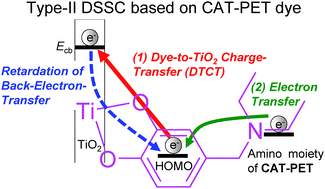当前位置:
X-MOL 学术
›
Mater. Chem. Front.
›
论文详情
Our official English website, www.x-mol.net, welcomes your feedback! (Note: you will need to create a separate account there.)
Photovoltaic performances of type-II dye-sensitized solar cells based on catechol dye sensitizers: retardation of back-electron transfer by PET (photo-induced electron transfer)
Materials Chemistry Frontiers ( IF 7 ) Pub Date : 2017-06-27 00:00:00 , DOI: 10.1039/c7qm00211d Yousuke Ooyama 1, 2, 3, 4, 5 , Kosuke Yamaji 1, 2, 3, 4, 5 , Joji Ohshita 1, 2, 3, 4, 5
Materials Chemistry Frontiers ( IF 7 ) Pub Date : 2017-06-27 00:00:00 , DOI: 10.1039/c7qm00211d Yousuke Ooyama 1, 2, 3, 4, 5 , Kosuke Yamaji 1, 2, 3, 4, 5 , Joji Ohshita 1, 2, 3, 4, 5
Affiliation

|
Catechol dyes (CAT-PET), possessing PET (photo-induced electron transfer) characteristics as well as dye-to-TiO2 charge-transfer (DTCT) characteristics, which are composed of a catechol unit linked to a diethylamino group as an electron donor moiety via a methylene spacer, have been designed and developed as dye sensitizers for type-II dye-sensitized solar cells (DSSCs). The PET takes place from the nitrogen atom of the amino moiety to the photoexcited catechol unit, that is, the CAT-PET dyes make it possible to retard the back-electron transfer rate from the electrons injected into the TiO2 electrode to the oxidized catechol unit by the PET characteristic in type-II DSSCs. The CAT-PET dyes exhibited a broad absorption band corresponding to DTCT upon binding to TiO2 films, and the DTCT band for the CAT-PET dyes broadened and showed a red-shift compared to that for CAT dyes without PET characteristics. In addition, our results demonstrate that the introduction of moderately electron-withdrawing substituents on the catechol unit for the CAT dyes, but strongly electron-withdrawing substituents as well as moderately electron-withdrawing substituents on the catechol unit for the CAT-PET dyes leads to enhancement of the DTCT characteristics. It was found that the photovoltaic performances of DSSCs based on the CAT-PET dyes are higher than those based on CAT dyes. This indicates that the PET from the diethylamino group to the oxidized catechol dye adsorbed on the TiO2 electrode can efficiently retard the back-electron-transfer, leading to favorable conditions for the type-II electron-injection pathway from the ground state of the catechol unit to the conduction band (CB) of the TiO2 electrode by the photoexcitation of DTCT bands. Consequently, this work proposes that introducing PET characteristics to the catechol dye with a moderately electron-withdrawing substituent is an effective molecular design for type-II dye sensitizers to lead to not only an increase in the DTCT efficiency, but also the retardation of back electron transfer.
中文翻译:

基于邻苯二酚染料敏化剂的II型染料敏化太阳能电池的光伏性能:通过PET阻止背电子转移(光致电子转移)
邻苯二酚染料(CAT-PET),具有PET(光致电子转移)特性以及染料与TiO 2的电荷转移(DTCT)特性,由与二乙氨基连接的邻苯二酚单元作为电子组成已经设计并开发了通过亚甲基间隔基的供体部分作为II型染料敏化太阳能电池(DSSC)的染料敏化剂。PET从氨基部分的氮原子到光激发的邻苯二酚单元发生,也就是说,CAT-PET染料可以阻止从注入TiO 2电极的电子到氧化的邻苯二酚的背电子传输速率II型DSSC的PET特性确定单位。该CAT-PET与不具有PET特性的CAT染料相比,CAT-PET染料的DTCT谱带在结合到TiO 2膜上时显示出对应于DTCT的宽吸收带,并且DTCT谱带变宽并显示出红移。此外,我们的结果表明,CAT染料在邻苯二酚单元上引入适度吸电子取代基,而CAT-PET染料在邻苯二酚单元上引入强吸电子取代基以及吸电子取代基增强DTCT特性。发现基于CAT-PET染料的DSSC的光伏性能要高于基于CAT-PET染料的DSSC的光伏性能。CAT染料。这表明从二乙氨基到吸附在TiO 2电极上的氧化邻苯二酚染料的PET可以有效地阻止背电子转移,从而为从儿茶酚的基态到II型电子注入途径创造了有利条件。DTCT带的光激发作用使TiO 2电极与TiO 2电极的导带(CB)结合。因此,这项工作提出将PET特性引入具有适度吸电子取代基的邻苯二酚染料是II型染料敏化剂的有效分子设计,不仅会导致DTCT效率的提高,而且还会导致背电子的阻滞转移。
更新日期:2017-10-26
中文翻译:

基于邻苯二酚染料敏化剂的II型染料敏化太阳能电池的光伏性能:通过PET阻止背电子转移(光致电子转移)
邻苯二酚染料(CAT-PET),具有PET(光致电子转移)特性以及染料与TiO 2的电荷转移(DTCT)特性,由与二乙氨基连接的邻苯二酚单元作为电子组成已经设计并开发了通过亚甲基间隔基的供体部分作为II型染料敏化太阳能电池(DSSC)的染料敏化剂。PET从氨基部分的氮原子到光激发的邻苯二酚单元发生,也就是说,CAT-PET染料可以阻止从注入TiO 2电极的电子到氧化的邻苯二酚的背电子传输速率II型DSSC的PET特性确定单位。该CAT-PET与不具有PET特性的CAT染料相比,CAT-PET染料的DTCT谱带在结合到TiO 2膜上时显示出对应于DTCT的宽吸收带,并且DTCT谱带变宽并显示出红移。此外,我们的结果表明,CAT染料在邻苯二酚单元上引入适度吸电子取代基,而CAT-PET染料在邻苯二酚单元上引入强吸电子取代基以及吸电子取代基增强DTCT特性。发现基于CAT-PET染料的DSSC的光伏性能要高于基于CAT-PET染料的DSSC的光伏性能。CAT染料。这表明从二乙氨基到吸附在TiO 2电极上的氧化邻苯二酚染料的PET可以有效地阻止背电子转移,从而为从儿茶酚的基态到II型电子注入途径创造了有利条件。DTCT带的光激发作用使TiO 2电极与TiO 2电极的导带(CB)结合。因此,这项工作提出将PET特性引入具有适度吸电子取代基的邻苯二酚染料是II型染料敏化剂的有效分子设计,不仅会导致DTCT效率的提高,而且还会导致背电子的阻滞转移。



























 京公网安备 11010802027423号
京公网安备 11010802027423号